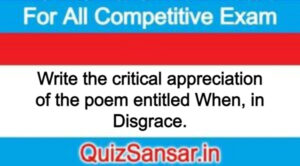
Write the critical appreciation of the poem entitled When, in Disgrace.
Write the critical appreciation of the poem entitled When, in Disgrace.
Ans.
Introduction
The sonnet No. 29 entitled When, in Disgrace was first published in 1609. There is nothing in the poem that would provide a clue as to whether the poem is directed towards a man or a woman. It is uncertain whether the state of disgrace referred to in this sonnet is a real or imaginary one for there is no external evidence. Certainly the years in which Shakespeare wrote Lear and Timon of Athens seem not to have been the happiest of times, but it is almost impossible to correlate particular events in his life, and the possible emotional crises that they could have produced. with publication dates, or known dates of production of his plays. The sorrow quoted here might be more rhetorical than real, being part of the sonnet tradition, in which many misfortunes contrive to make the lover unhappy. It also serves to highlight the great joy which ends the poem, when he thinks once more of his friend, as in the psalms, and rises above the clouds,
Thought-Content
The sonnet begins with a pessimistic note. The poet feels that he is going through a phase of misfortune and is being treated as a social outcast. It is generally assumed that when a person is in an unpleasant or unenviable situation, society also distances itself from him. Thus, the poet’s misery is intensified, as he finds himself completely alone in his difficulties. However, the strong emotions expressed in the sonnet suggest that these negative feelings are not unfamiliar to him. He curses his fate and prays to God but his prayers go unheard. Completely dishertened by his situation, he wishes he could be more like other men-more hopeful, better looking, with plenty of friends, or having some special skill and more freedom. By the end of the poem we get the feeling that the poet is actually enjoying himself.
The Use of References, Allusions and Phrases
Fortune refers to the medieval and ancient philosophy. It is said to be made of four stages: on top of the wheel, on the right side of the wheel, on the bottom of the wheel, and on the left side of the wheel. If the speaker is in disgrace with Fortune, then he is most likely at the bottom of the wheel with no hope of reaching top. To be in disgrace with fortune is presumably to be not favoured by her.
“O! for my sake do you with Fortune chide,
The guilty goddess of my harmful deeds.”
Disgrace is a term which would more usually be applied to a demotion or removal from office. Or a final humiliation and loss of status.
Heaven (God) turns a deaf ear to the poet’s complaints and laments. Curse my fate is another echo from the Book of Job in the Bible.
Religious Nature of the Sonnet
Religious references are made throughout the poem. The speaker first states that heaven is deaf to his “bootless (useless) cries” (line 2). The “lark at break of day arising” (line 11) symbolises the speaker’s rebirth to a life where he can now sing “hymns at heaven’s gate (line 12). This creates another contrast in the poem. The once deaf heaven that caused the speaker’s prayers to be unanswered is now suddenly able to hear. The Sonnet says that God disappoints and that the young man redeems. This is to say that the poem is not religious in the institutional way but rather it is its own kind of religion.
Structure of the Sonnet
Sonnet 29 follows the same basic structure as Shakespeare’s other sonnets, containing fourteen lines and written in iambic pentameter, and composed of three rhyming quatrains with a rhyming couplet at the end. However, it does not follow the traditional English rhyme scheme of abab cdcd efef gg. Rather the scheme is abab cdcd ebeb ff. Sonnet 29 includes two distinct sections with the speaker explaining his current depressed state of mind in the first octave and then conjuring what appears to be a happier image in the last sestet.
Stylistically the sonnet is typically Shakespearean in its form. The first eight lines, which begin with “When,” establish a conditional argument and show the poet’s frustration with his craft. The last six lines, expectedly beginning in line 9 with “yet”-similar to other sonnets “But”-and resolving the conditional argument, present a splendid image of a morning lark that sings hymns at heaven’s gate.
- What is meant by Database Management System?
- Discuss the advantages and drawbacks of database.
- What do you mean by database ? Discuss its Characteristics.
- What is Data Mining?
- What are the conditions of communication?
- What do you mean by business communication ?
- organization / Differentiate between classical and modern theory of organization
- What is forecasting






